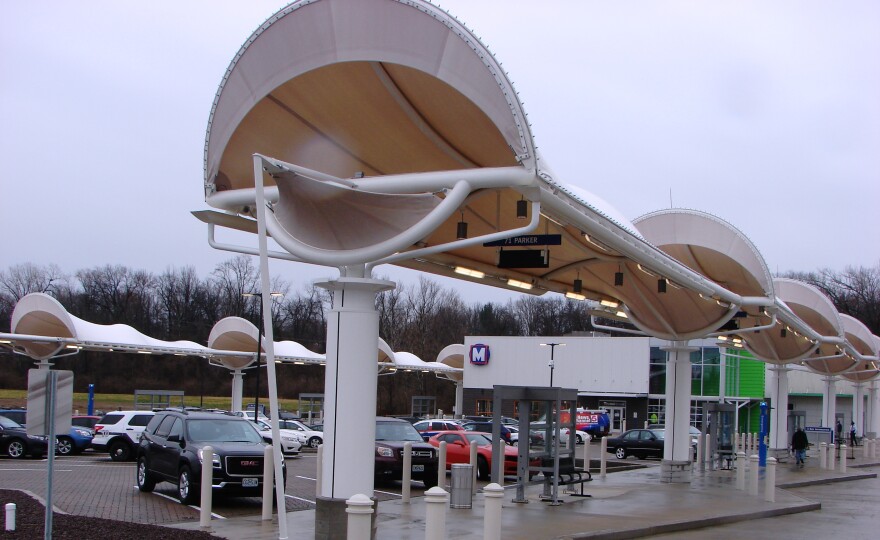Dozens of Metro bus drivers are tracing new routes through north St. Louis County starting this week. The service changes stem from the new North County Transit Center that opened Monday in Ferguson to serve one of the area’s fastest growing markets.
On a cold March morning, Cliff Harper stands in the wind, about to board the #35 Earth City at the North Hanley Metro station. His commute to Boeing is changing, as are thousands of others with Metro’s new bus service plan this week.
“Well, actually it’ll make mine easier,” Harper said. “Because there’ll be two different buses going toward where I need to go instead of just one. One runs every 40 minutes; I should be able to catch one every 20 minutes of the two.”
Breysha Vanarsdale, who commutes from south St. Louis, echoed what many of her fellow riders said about learning the new system.
“I’ve been taking one bus for a really long time and now they have all these different routes so then you got to look up which route you gotta take, but once you get used to it, you’ll get used to it,” she said.
Metro's expanding service includes nine new or redesigned routes, longer late-night and weekend hours and more direct lines to destinations like Clayton and downtown St. Louis.
New Transit Hub in Ferguson
Metro is also expanding its service to more neighborhoods like Spanish Lake and includes the new #79 Ferguson line which starts at North Hanley Station and ends at the North County Transit Center in Ferguson.
The $10.3 million facility has been part of Metro’s plan since 2009 and the final hub of Metro’s current hub-and-spoke system. It features 10 bus bays, an indoor waiting area, public restrooms, and free parking. Metro is also planning for concessions vendor to set up shop at the center by this summer.

Most importantly, the center allows for faster connections, and faster trip times, said Metro’s Chief of Planning and System Development Jessica Mefford-Miller.
“That’s what customers want the most,” she said. “It will make transit more competitive and the transit center’s going to allow us to link residential communities with important destinations like job centers, health care and education institutions faster.”
The new center and system redesign are part of Metro’s efforts to meet growing demand in north

St. Louis County, which accounts for 19 percent of Metro’s bus and train ridership. The upgrades are a large component of restoring service that Metro cut by nearly a third in 2009 due to budget shortfalls.
In addition to hosting numerous community outreach events, the transit group worked with census data to configure the most optimal routes, Mefford-Miller said.
“We also looked at major destinations like schools and employment centers and for many large employment centers we’re working with them directly so that we can time our service to their trip times and shift times,” she said, explaining that 75 percent of Metro riders take transit to get to work.
Neighborhood Upgrades
Metro’s investments in north St. Louis County are good news for many workers who commute across the region, but the facility itself is a welcome improvement for the city of Ferguson too.
During its ribbon cutting ceremony March 10, Metro President and CEO John Nations said it’s north St. Louis County’s biggest investment in transit infrastructure since MetroLink opened in 1993. Ferguson Mayor James Knowles III called the center at 3140 Pershall Road a significant upgrade from the vacant car dealership that it was before.
“Less than two years ago, this building was a symbol of blight and decay,” Knowles said. “Next to us was a dilapidated strip center, which was not only an eyesore, but a haven for criminal activity. We are grateful to have worked with Metro to acquire this land next door and help clear that blight.”
Federal Funding
The center’s cost has also been welcome news: federal grants paid for roughly 80 percent of the facility’s construction. And, about half of the additional $5 million in operating expenses for the center and new services will be covered by federal grants – at least, for the next three years.
The funding is crucial as Metro works to increase service and infrastructure without leaning on local taxpayers for more money. Mefford-Miller said Metro set aside funds for several years to offset some of the added costs.
“We also expect that ridership will grow in response to this new service,” Mefford-Miller said. “And we give that three-year timeline for ridership to grow and stabilize.”
But, increasing ridership won’t likely make up for the federal government’s portion down the road, said Mefford-Miller, because bus fares pay for only about 20 percent of the system’s total costs.
So, eventually, more funding will be needed to sustain the system as it is now.
Follow Joseph on Twitter: @joemikeleahy



